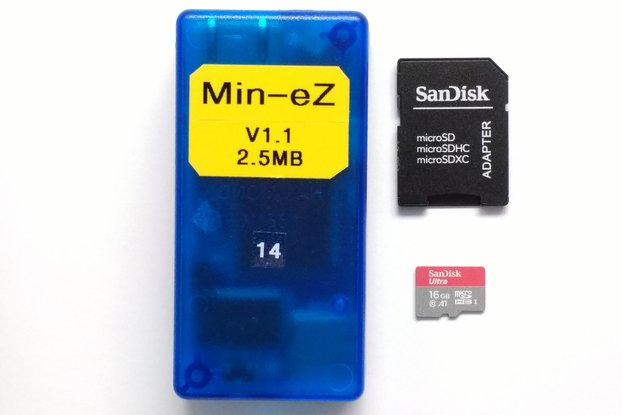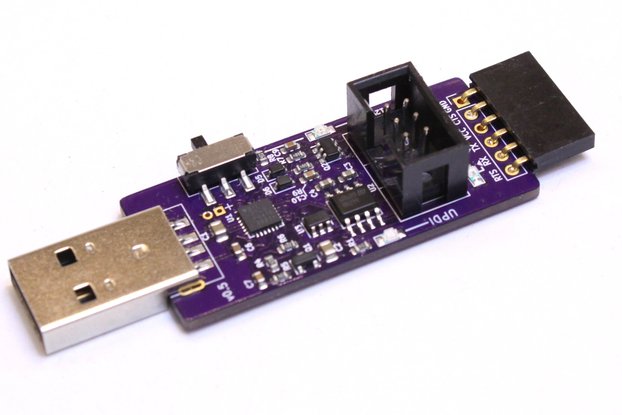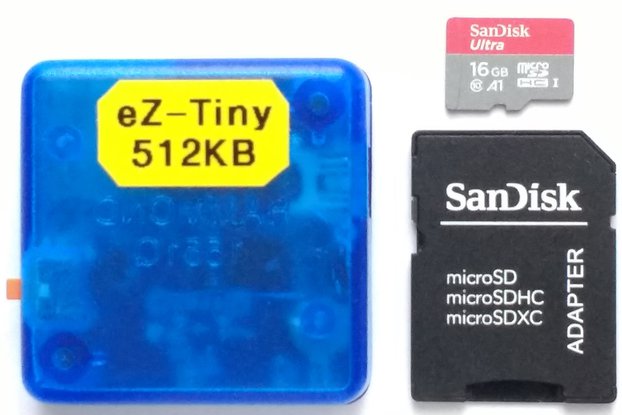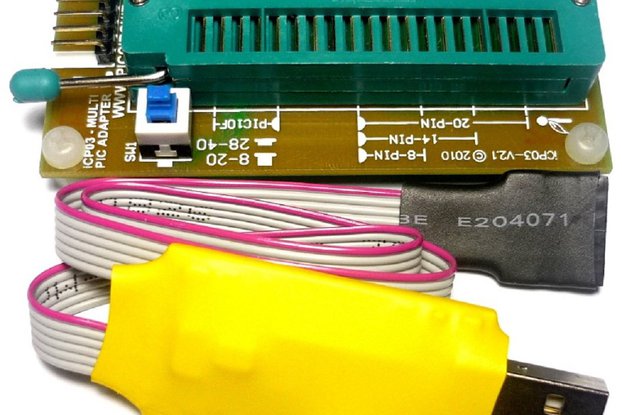USB based SWD programmer and debugger for OSHChip, including Drag-and-Drop programming and USB to Serial
Designed by OSHchip in United States of America
This product is no longer available for sale.
The seller may be offering an improved version or it may be hanging out on the beach, enjoying the retired life.
Programming OSHChip contains 256 K Bytes of on-chip Flash memory which is used for your application program, the optional radio protocol software stack (such as Bluetooth Low Energy (BLE) or Gazell) …
Read More…OSHChip contains 256 K Bytes of on-chip Flash memory which is used for your application program, the optional radio protocol software stack (such as Bluetooth Low Energy (BLE) or Gazell) and also for non-volatile storage. After you have written your application program and compiled it successfully, your next step it to program the on-chip Flash memory with the compiled and linked image. This is usually a .HEX file. OSHChip_CMSIS_DAP_V1.0 is the tool for the job.
With many alternative processor boards, in particular the various Arduino and mbed devices, that would be the end of the story: Download your program, and if it doesn't work, your available debug tools are pretty much limited to flashing a LED, or using printf() to display the value of some variables at one point in the program, at one particular time. OSHChip has a much more sophisticated solution thanks to the extensive debug support built into the Keil IDE and the CMSIS-DAP functionality provided by OSHChip_CMSIS_DAP_V1.0 . With this combination, you get best in class capabilities such as break points, examining and changing memory, single stepping through your code, and even breakpoints when a variable is read or written or matches a specific value. Once you have used this type of debugging functionality, you won't want to go back to just flashing a LED or using printf().
OSHChip V1.0 has a small 4 pin connector on the top side that is used for programming the Flash memory, and can also be used for debugging. The 4 pins are the minimal pins needed to implement the ARM Cortex SWD interface. SWD is used on ARM processors from many companies, and so OSHChip_CMSIS_DAP_V1.0 can be used with products other than OSHChip. The SWD standard specifies a 10 pin (2 by 5) connector with pin spacing in X and Y of 0.050" (1.27mm). To convert from the 2 by 5 layout on the OSHChip_CMSIS_DAP_V1.0 to the 2 by 2 layout on the OSHChip V1.0, a small adapter OSHChip SWD 2x2 Adapter is provided.
A cable and an adapter are shipped with each OSHChip_CMSIS_DAP_V1.0
OSHChip_CMSIS_DAP_V1.0 connects to a host computer over a USB 2.0 interface and provides 3 services:
USB to CMSIS-DAP programming with a SWD connection to the target. Use this with the Keil IDE. This should be able to program any processor that the Keil IDE supports (there are hundreds) that can be programmed via SWD. There is also support for debugging with GCC's GDB debugger, via pyOCD. Although not yet tested, OSHChip_CMSIS_DAP_V1.0 should also be compatible with OpenOCD.
USB MSD (Mass Storage Device), shows up like a USB memory stick/drive, named MBED or OSHChip 1.0. You can drag and drop .HEX files to this drive, and it will convert the file to the appropriate SWD pin wiggling and program a nRF51822 which is the processor on OSHChip_V1.0. This drag and drop interface only works with nRF51822 target processors.
USB to virtual COM port. The OSHChip_CMSIS_DAP_V1.0 provides serial I/O at LVTTL (0 to 3.3V) levels on the 2 pin header on the end of the board. These can be connected to anywhere in your system that has async serial I/O, so no specific pins on OSHChip_V1.0 are required. This interface has been tested extensively at 9600 Baud, but it should work at up to 115200 Baud.
OSHChip_CMSIS_DAP_V1.0 is an Open Source Hardware product. It's right there in the name. You can find all the schematics, bill of materials, printed circuit board design files and the resultant Gerber files here:
https://github.com/OSHChip/OSHChip_CMSIS_DAP_V1.0_Docs
The repository contains the design files for OSHChip_CMSIS_DAP_V1.0
The PCB design files are in the directory Design_Files and were created with Altium Designer Release 10
Since you may not have access to Altium Designer, I have also included all the Gerber files and the Excelon drill file in the directory Gerbers_and_Drill_Files.
In the Other_Files directory, you will find the following:
Thank you for considering OSHChip for your project. Typically orders are for one or more OSHChips_V1.0 and one OSHChip_CMSIS_DAP_V1.0 . That's because usually you are only programming/debugging one design at a time. If you have a more complex project where you need to debug more than one OSHChip concurrently, you will need a programmer/debugger for each of the concurrent designs, and probably a computer that can run multiple copies of the Keil IDE concurrently, or multiple computers
If you order OSHChip_V1.0 and OSHChip_CMSIS_DAP_V1.0 together, your order will be shipped together for one flat rate, regardless of how many of each you order.
Each OSHChip_CMSIS_DAP_V1.0 programmer/debugger comes with an SWD programming cable, which is a 10 wire ribbon cable with a 0.050" pitch 2 by 5 pin female keyed IDC connector at each end, and an SWD 2x5 to 2x2 Adapter designed specifically for OSHChip V1.0.
The OSHChip_CMSIS_DAP_V1.0 programmer/debugger connects to your computer via a USB cable that has a Mini-B plug at the OSHChip_CMSIS_DAP_V1.0 end. The USB cable is not supplied by OSHChip.
You may not need to buy an OSHChip_CMSIS_DAP_V1.0 if you already have an SWD programmer, with the required 0.050" pitch 2 by 5 connector and flatflex cable. You can get by without the OSHChip adapter, if you follow the instructions at the bottom of this page:
Connecting and using the serial data interface
You can find further details and documentation on the OSHChip Web Site
Product: (5.00)
Documentation: (2.33)
Shipping: (4.00)
Communication: (3.00)
Trevor | March 30, 2016
Trevor | March 30, 2016
Trevor | March 30, 2016
Sunnyvale, CA, United States of America
Ships from United States of America.
7 Reviews | 206 Orders

$135.00
Free Shipping!

$35.00
Free Shipping!

$95.00
Free Shipping!

$31.90
Free Shipping!
By clicking Register, you confirm that you accept our Terms & Conditions
We recognize our top users by making them a Tindarian. Tindarians have access to secret & unreleased features.
We look for the most active & best members of the Tindie community, and invite them to join. There isn't a selection process or form to fill out. The only way to become a Tindarian is by being a nice & active member of the Tindie community!
